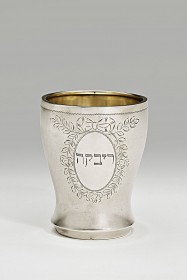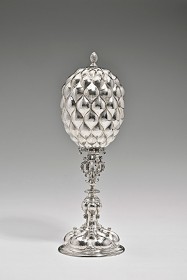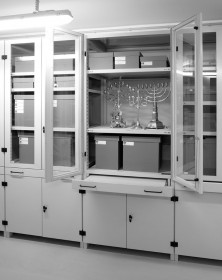It’s cold. The neon light casts a harsh glare. A gray cabinet stands next to another along white walls. The room feels sterile. The air conditioning hums. A gloomy place.
I put on blue, latex gloves, open one of the cabinets and take out a gray carton. Contours of an item shimmer from under layers of tissue paper. Carefully, I take the object out of the carton and free it from the paper; a microcosm of history presents itself, as if this gloomy place accentuates the aura of the item, the room itself taking a whole step back.
French historian Arlette Farge vividly described this palpable experience as “Le goût de l’archive” (the taste of the archive); I’m repeatedly struck by how much it characterizes my work in the collections storage area.
As an academic trainee in the collections department, it’s one of my main tasks to prepare ceremonial objects and objects of applied arts for online search. Research and description, copyright declaration and indexing are central to my daily work. Sifting through storage is the beginning, for all intents and purposes it’s the first introduction to the item. Research follows, building on existing findings with yet unknown details. This process is different for each item – at times bringing new aspects of the production process to light, at others particular understanding of its use.
This research puts us in touch with a wealth of themes, contexts and experiences. Most items have changed hands and locations multiple times. Often they were for joyous events, for example as a Bar Mitzvah gift. Some are intended to serve as reminders of significant Jewish figures. Many witnessed escape and destruction; others – due to their avant garde nature – were denounced as “degenerate” during National Socialism. These items speak of life in exile, the reconstruction of Jewish life in Germany after 1945 and the quest for contemporary design.

Presumed Kiddush Cup, silver, engraved, Germany ca. 1888-1900,© Jewish Museum Berlin, photo: Martin Adam
Many questions remain even after the baseline research, which itself can lead to new questions. Such was the case with a small, silver cup. The modest cup was made in the late 19th century and features a wreathed medallion on its front with the engraved Hebrew name, Rivka (Rebecca). Who was she? What did she use the cup for? Was it a gift for a birth or wedding? Was the name engraved when the cup was first made or only years later? These questions are likely never to be fully answered, leaving room for speculation. Could this cup have been a reflection of a particular development in gender history at the close of the 19th century? After all, it was the rise of bourgeois and accompanying differentiation of gender roles and gender-specific space that moved Jewish women from the periphery to the middle of religious happenings in the course of the 19th century. American historian Marion Kaplan especially made this a focus of her research in the 1990s, characterized under the subject “Female custodians of tradition”. Women were empowered by their responsibility to look after family ritual and pass it to the next generation. Was it also the case for this Rivka? The cup’s Hebrew inscription seems to suggest it was meant for religious purposes – as a kiddush cup, used on Shabbat and other Jewish holidays to say the blessing over wine.

Elijah’s Cup, silver, chased, cast, engraved, Bremen ca. 1888, © Jewish Museum Berlin, photo: Martin Adam
What about when the item reveals nothing about its ritual use, as with the so-called Pineapple Goblet in the Jewish Museum’s collection (also known as the Grape or Hunchback Goblet)? Its style was a favorite in the late 16th century and was back in vogue at the end of the 19th century thanks to the Renaissance Revival. This particular form, which personally piques my curiosity, has actually very little to do with “classical Judaica”. The family who donated the goblet to the Museum used it for generations as its Elijah’s cup – the ceremonial cup filled with wine during the Passover seder (this year taking place on Friday, 3 March) and left on the table for the prophet Elijah, whose presence is to signal the coming of the Messiah. In using this item as such, the exotic Pineapple Goblet has clearly earned its place among the Museum’s Judaica collection.
Often in the process of organizing Judaica into theoretically concrete categories or contexts, items such as the Pineapple Goblet resist all attempts to be clearly defined. Flexible thinking is therefore required when describing and categorizing. And this makes my work with archival items all the more exciting and unique.
Anna-Carolin Augustin is currently working as academic trainee in the collections department with the area of interest ceremonical objects and applied arts.
